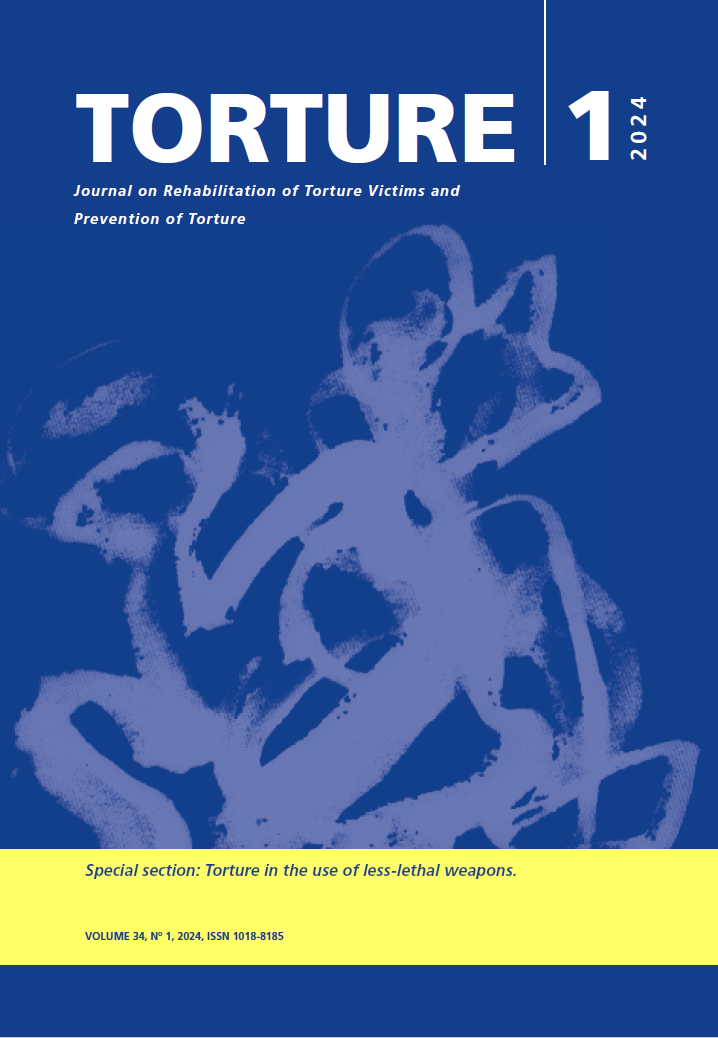Assessment and litigation of ocular injuries by less-lethal weapons.
DOI:
https://doi.org/10.7146/torture.v34i1.144838Palabras clave:
Less-Lethal weapons, Eye mutilation, Forensic Assessment, TortureResumen
The main cause of serious ophthalmological injuries, including
violent eye amputations in the context of so-called less lethal
weapons, is the use of blunt objects, such as batons or extendable
sticks and the use of kinetic energy projectiles (rubber bullets,
pellets, foam projectiles or others). Such injuries in the context
of population control have been considered to constitute cruel,
inhuman or degrading treatment or even torture when they are
carried out, intentionally or unintentionally, by State officials
(or with their acquiescence or protection) and involve any of the
purposes contemplated in the Convention against Torture. Due
to their special characteristics, they constitute rights violations
that entail unique difficulties and complexity from both a legal
and forensic point of view. This paper addresses some of these
difficulties with practical legal and forensic recommendations.
It is structured in two parts: First, legal, where we consider
legal difficulties and provide suggestions on elements for obtaining
evidence are given. Second, medico-psychological and
forensic where we review the elements to be considered in the
interview, the medical and ophthalmological evaluation, and
the psychometric, psychological and psychiatric evaluation.
Citas
Amnesty International, & Omega Research. (2023). “ My eye exploded”. The global use of kinetic impact projectiles.
Beck, A. T., Steer, R. A., & Brown, G. (1996). Beck Depression Inventory–II (BDI-II). APA Psychometric Database. https://doi.org/https://doi.org/10.1037/t00742-000
Blevins, C. A., Weathers, F. W., Davis, M. T., Witte, T. K., & Domino, J. L. (2015). The Posttraumatic Stress Disorder Checklist for DSM-5 (PCL-5): Development and Initial Psychometric Evaluation. Journal of Traumatic Stress, 28(6). https://doi.org/10.1002/jts.22059
Broman, A. T., Munoz, B., West, S. K., Rodriguez, J., Sanchez, R., Snyder, R., & Klein, R. (2001). Psychometric properties of the 25-item NEI-VFQ in a Hispanic population: Proyecto VER. Investigative Ophthalmology & Visual Science, 42(3), 606–613. http://www.ncbi.nlm.nih.gov/pubmed/11222517
Lim, Z. W., Chee, M. L., Da Soh, Z., Cheung, N., Dai, W., Sahil, T., Tao, Y., Majithia, S., Sabanayagam, C., Chen, C. L. H., Wong, T. Y., Cheng, C. Y., & Tham, Y. C. (2020). Association between Visual Impairment and Decline in Cognitive Function in a Multiethnic Asian Population. JAMA Network Open, 3(4), 1–12. https://doi.org/10.1001/jamanetworkopen.2020.3560
Nasreddine ZS, Phillips NA, B. V. (2005). The Montreal cognitive assessment, MoCA: a brief screening tool for mild cognitive impairment. . 2005;53:695-9. JAGS, 53, 695–699.
Pérez-sales, P., Eiroa-orosa, F. J., Olivos, P., Barbero-val, E., Fernández-liria, A., & Vergara, M. (2012). Vivo Questionnaire : A Measure of Human Worldviews and Identity in Trauma , Crisis , and Loss — Validation and Preliminary Findings. Journal of Loss and Trauma : International Perspectives on Stress & Coping, February 2013, 236–259.
Rocher, P. (2020). Gazer, mutiler, soumettre: Politique de l’arme non létale. (La Fabrique Editions. (ed.)).
Stelmack, J. A., Tang, X. C., Wei, Y., Wilcox, D. T., Morand, T., Brahm, K., Sayers, S., & Massof, R. W. (2017). Outcomes of the Veterans Affairs Low Vision Intervention Trial II (LOVIT II). JAMA Ophthalmology, 135(2), 96. https://doi.org/10.1001/jamaophthalmol.2016.4742
Velasquez, J., Sanchez, R., Severin, I., & Sferrazza, P. (2022). Estudios interdiciplinarios para investigar las violaciones a los derechos humanos por armas menos letales (T. Lo Blanch (ed.)). Tirant lo Blanc.
Vélez, C. M., Ramírez, P. B., Oviedo-Cáceres, M. D. P., Lugo Agudelo, L. H., Posada, A. M., Hernández-Padilla, M. L., Valverde, E. A., & Suárez-Escudero, J. C. (2023). Psychometric Properties of Scales for Assessing the Vision-related Quality of Life of People with Low Vision: A Systematic Review. Ophthalmic Epidemiology, 30(3), 239–248. https://doi.org/10.1080/09286586.2022.2093919
Weih, L. M., Hassell, J. B., & Keeffe, J. (2002). Assessment of the impact of vision impairment. Investigative Ophthalmology & Visual Science, 43(4), 927–935. http://www.ncbi.nlm.nih.gov/pubmed/11923230
Wolffsohn, J. S., & Cochrane, A. L. (2000). Design of the low vision quality-of-life questionnaire (LVQOL) and measuring the outcome of low-vision rehabilitation. American Journal of Ophthalmology, 130(6), 793–802. https://doi.org/10.1016/S0002-9394(00)00610-3

Descargas
Publicado
Cómo citar
Número
Sección
Licencia
Derechos de autor 2024 Torture Journal

Esta obra está bajo una licencia internacional Creative Commons Atribución-NoComercial-SinDerivadas 4.0.
We accept that some authors (e.g. government employees in some countries) are unable to transfer copyright. The Creative Commons Licence Attribution-NonCommercial-NoDerivatives 4.0 International (CC BY-NC-ND 4.0) covers both the Torture Journal and the IRCT web site. The publisher will not put any limitation on the personal freedom of the author to use material contained in the paper in other works which may be published, provided that acknowledgement is made to the original place of publication.

